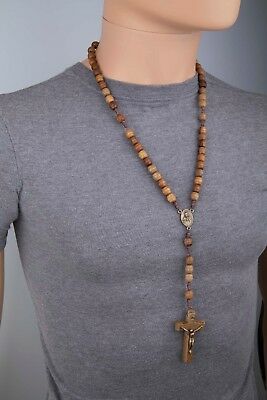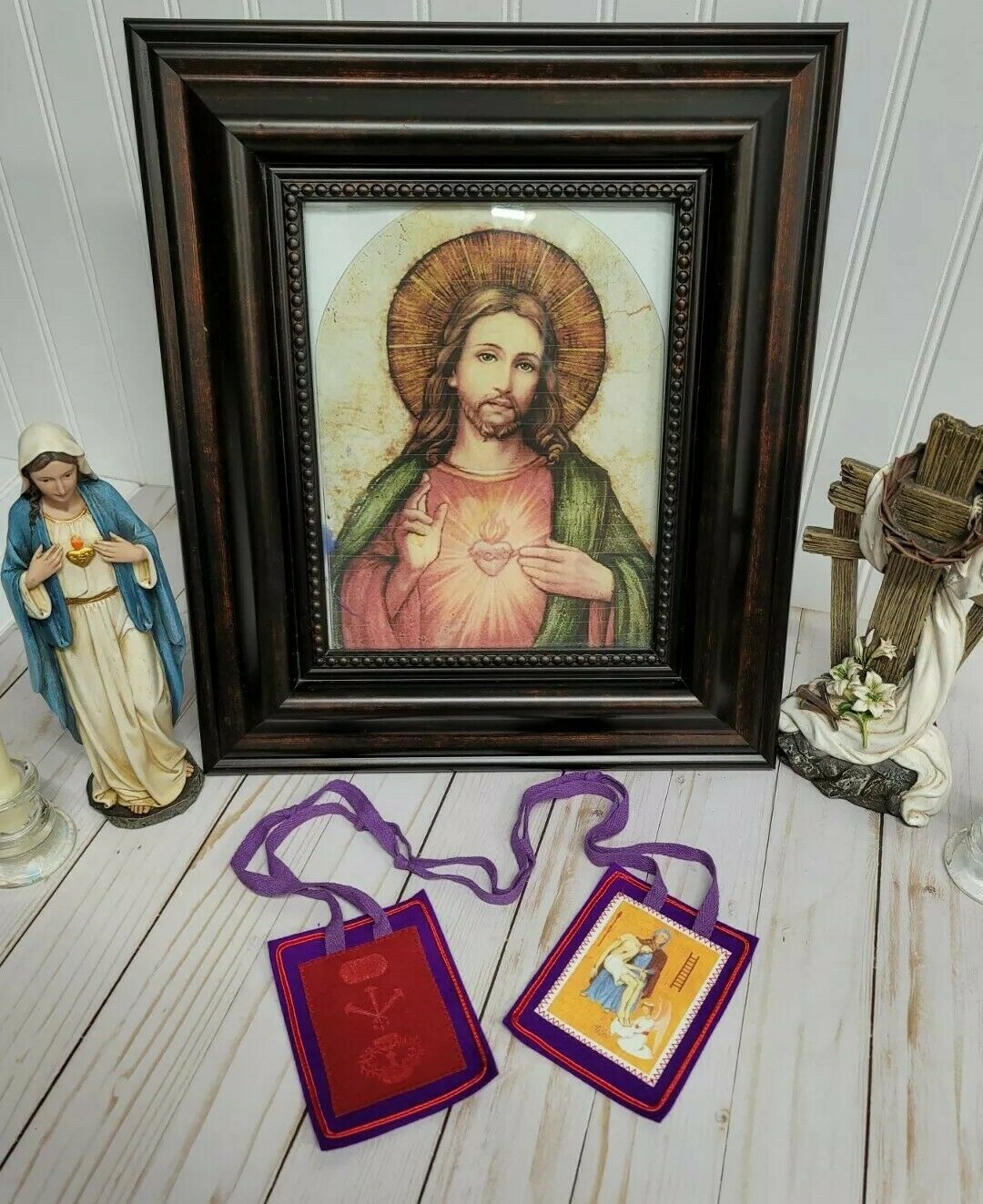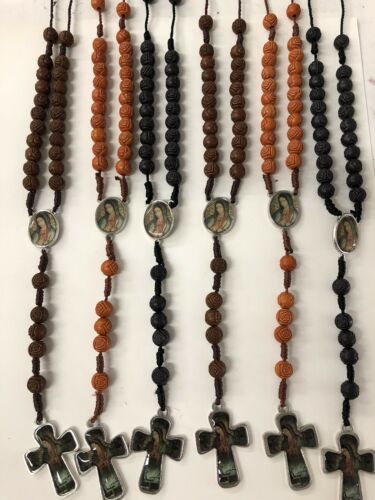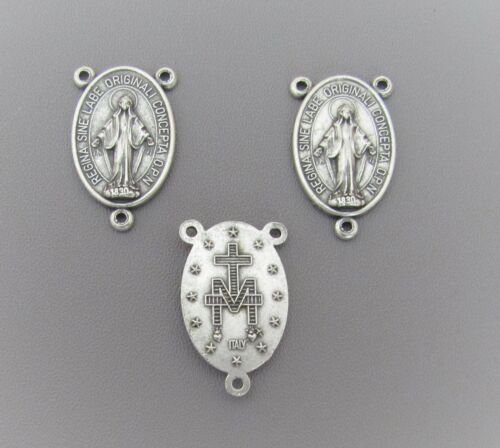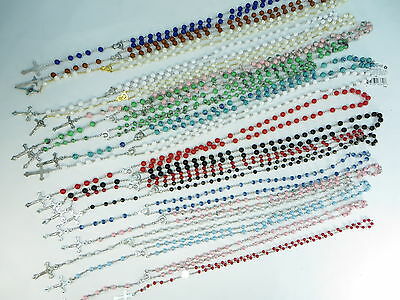-40%
Sterling 925 Silver Lapis lazuli Beads Rosary CROSS CRUCIFIX CATHOLIC NECKLACE
$ 52.79
- Description
- Size Guide
Description
925 Silver 6 cm Cross Lapis lazuli & Fire Coral RosaryValuable . Precious . Rare
925 Silver 6 cm Cross Lapis Lazuli
& Fire Coral Rosary
Sterling Natural Lapis Lazuli Bead : 8MM
925 Silver Fire Coral : 9MM
Wire Wrapped Beads + 925 Silver Special Flower Mate
WEIGHT: 180 G
QUALITY: HIGH QUALITY
6 cm Crucifix Material : 925 Silver
Rosary: 58 cm Length from the Cross to the end
Natural Fire Coral Bead : 10 MM
You are Biding on a nice 925 silver 6 cm Cross Lapis lazuli & Fire Coral Rosary, It has Shaped Super Lapis lazuli BEADS Rosary,With Each Speclal Lapis lazuli Bead Being Round.Well Kept with no cracks at all.Its appearance and quality are excellent.
Offering for your spiritual life, witness wear, or gift giving, a stunning religious rosary from olden oridental. This Rosaryis so one size Fits most teens/adults,Very stylish and unique, great religious's witness wear, great prayer reminder, and thanks for looking.this is a Heritage piece you will pass down to your children--or an exceptional one-of-a-kind gift.
I'm sorry due to the limit of my camera, I cannot present the complete beauty of this bead to you. If you have the chance to get this Rosary, please don't forget to admire it under light.This Rosary will become part of your life!
If you have any questions or you need more information about this or any other product, please email me.Please take a moment to browse through the other lovely jewelry items in my store, and add me to your list of favorites.
Special Flower Mate: Tibet Silver
Wire Wrapped Beads / Chain:White Copper
Lapis lazuli
Lapis lazuli is a semi-precious stone prized since antiquity for its intense blue color.
Lapis lazuli has been mined in the Badakhshan province of Afghanistan for 6,500 years, and trade in the stone is ancient enough for lapis jewelry to have been found at Predynastic Egyptian sites, and lapis beads at neolithic burials in Mehrgarh, the Caucasus, and even as far from Afghanistan as Mauritania.
Description
Lapis lazuli is a rock, not a mineral: whereas a mineral has only one constituent, lapis lazuli is formed from more than one mineral.
The main component of lapis lazuli is lazurite (25% to 40%), a feldspathoid silicate mineral composed of sodium, aluminium, silicon, oxygen, sulfur, and chloride. Its formula is (Na,Ca)8(AlSiO4)6(S,SO4,Cl)1-2.Most lapis lazuli also contains calcite (white), sodalite (blue) and pyrite (metallic yellow). Other possible constituents are augite, diopside, enstatite, mica, hauynite, hornblende and nosean. Some contain trace amounts of the sulfur rich lollingite variety geyerite.
Lapis lazuli usually occurs in crystalline marble as a result of contact metamorphism.
The finest color is intense blue, lightly dusted with small flecks of golden pyrite. There should be no white calcite veins and the pyrite inclusions should be small. Stones that contain much calcite at all or too much pyrite are not as valuable. Patches of pyrite are an important help in identifying the stone as genuine and do not detract from its value. Often, inferior lapis is dyed to improve its color, but this is often a very dark blue with a noticeable grey cast, may also appear as a milky shade.
Uses
Lapis takes an excellent polish and can be made into jewelry, carvings, boxes, mosaics, ornaments and vases. In architecture it has been used for cladding the walls and columns of palaces and churches.
It was also ground and processed to make the pigment ultramarine for tempera paint and, more rarely, oil paint. Its usage as a pigment in oil paint ended in the early 19th century as a chemically identical synthetic variety, often called French Ultramarine, became available.
Etymology
Lapis is the Latin for 'stone' and lazuli the genitive form of the Medieval Latin lazulum, which is from the Arabic lazaward, which is ultimately from the Persian lazvard, the name of a place where
lapis lazuli was mined.The name of the place came to be associated with the stone mined there and eventually, with its color. The English word azure, the Spanish and Portuguese azul, and the Italian azzurro are cognates. Taken as a whole, lapis lazuli means "stone of Lazvard".
Sources
The best lapis lazuli is found in limestone in the Kokcha river valley of Badakhshan province in northeastern Afghanistan, and these deposits in the mines of Sar-e-Sang have been worked for more than 6,000 years.Badakhshan was the source of lapis for the ancient Egyptian and Mesopotamian civilizations, as well as the later Greek and Roman; during the height of the Indus valley civilization about 2000 B.C., the Harappan colony now known as Shortugai was established near the lapis mines.
More recently, during the 1980s conflict with the USSR, Afghanistan resistance fighters disassembled unexploded Soviet landmines and ordnance and used the scavenged explosive to help mine lapis to further fund their resistance efforts.
In addition to the Afghan deposits, lapis has been extracted for years in the Andes near Ovalle, Chile, where the deep blue stones compete in quality with those from Afghanistan. Other less important sources include the Lake Baikal region of Russia, Siberia, Angola, Pakistan, USA (California and Colorado), Canada and India.
Cul
tural and historical/mythical usage
In ancient Egypt lapis lazuli was a favorite stone for amulets and ornaments such as scarabs; it was also used by the Assyrians and Babylonians for seals. Lapis jewelry has been found at excavations of the Predynastic Egyptian site Naqada (3300-3100 BC), and powdered lapis was used as eyeshadow by Cleopatra.
As inscribed in the 140th chapter of the Egyptian Book of the Dead, lapis lazuli, in the shape of an eye set in gold, was considered an amulet of great power. On the last day of the month, an offering was made before this symbolic eye, for it was believed that, on that day, the supreme being placed such an image on his head.
The ancient royal Sumerian tombs of Ur, located near the Euphrates River in lower Iraq, contained more than 6000 beautifully executed lapis lazuli statuettes of birds, deer, and rodents as well as dishes, beads, and cylinder seals. These carved artifacts undoubtedly came from material mined in Badakhshan in northern Afghanistan. Much Sumerian and Akkadian poetry makes reference to lapis lazuli as a gem befitting royal splendor.
In ancient times, lapis lazuli was known as sapphire, which is the name that is used today for the blue corundum variety sapphire. It appears to have been the sapphire of ancient writers because Pliny refers to sapphirus as a stone sprinkled with specks of gold. A similar reference can be found in the Hebrew Bible in Job 28:6.
The Romans believed that lapis was a powerful aphrodisiac. In the Middle Ages, it was thought to keep the limbs healthy, and free the soul from error, envy and fear.
It was once believed that lapis had medicinal properties. It was ground down, mixed with milk and applied as a dressing for boils and ulcers.
Many of the blues in painting from medieval Illuminated manuscripts to Renaissance panels were derived from lapis lazuli. Ground to a powder and processed to remove impurities and isolate the component lazurite, it forms the pigment ultramarine. This clear, bright blue, which was one of the few available to painters before the 19th century, cost a princely sum. As tempera painting was superseded by the advent of oil paint in the Renaissance, painters found that the brilliance of ultramarine was greatly diminished when it was ground in oil and this, along with its cost, led to a steady decline in usage. Since the synthetic version of ultramarine was discovered in the 19th century (along with other 19th century blues, such as cobalt blue), production and use of the natural variety has almost ceased, though several pigment companies still produce it and some painters are still attracted to its brilliance and its romantic history.
Poetry/literature
Lapis lazuli is repeatedly mentioned in the Sumerian and Akkadian Epic of Gilgamesh. For instance, the Bull of Heaven's horns are composed of lapis lazuli. One version, at least, also suggests that the tale of Gilgamesh was recorded on a lapis lazuli tablet .Lapis Lazuli is a poem written by William Butler Yeats. Text available at Readprint.com It is also mentioned in Yeats' poem Oil and Blood.
Lapis Lazuli is also mentioned in Robert Browning's The Bishop Orders His Tomb at Saint Praxed's Church as the egotistical Bishop wished to have the rarest stone available to him for his soon to be tomb, ironically contradicting a Bishop's vow of simplicity.
Lapis lazuli also makes an appearance in Marianne Moore's poem, "A Talisman" - which is quoted by T. S. Eliot in his "Introduction to Selected Poems [of Marianne Moore]." The stanza of Moore's poem reads: "Of lapis-lazuli,/A scarab of the sea,/With wings spread-". Eliot, in the next paragraph, raises the question: "I cannot see what a bird carved of lapis-lazuli should be doing with coral feet; but even here the cadence, the use of rhyme, and a certain authoritativeness of manner distinguish the poem."
In Lorna Crozier's poem "The Memorial Wall", "a young man who'd come from Montana to find his brother's name paints the side door lapis lazuli".In D. H. Lawrence's novel Women in Love, a female character attempts to kill her lover after a quarrel by smashing his head with a lapis lazuli paperweight.
Wire Wrapped Beads
1.
the Bead and Wire Chain This is an extremely versatile technique which can be used for making bracelets, necklaces, or even earrings, so it's no surprise that's it has been so well received. In addition to making a chain using wire and beads, many wire lovers also like to wrap the beads in the chain with wire. As with the chain itself, this method of wire work is pretty has endless possibilities.
2.
if wrap the beads you need to take a few extra steps.you'll need: Wire, Beads,Round-nosed pliers,Wire cutters,Chain-nosed pliers,Jewelers' files
3.
Use dead-soft wire for this. The size of wire depends on the size of the hole in your beads. However, the sizes will vary. For example, if I'm using pearls to make this type of chain, I usually use 24 or 26 gauge sterling or gold-filled wire. If my beads are a little larger, I like to use 20, 21, or 22 gauge wire.
In Robert A. Heinlein's novel Time Enough for Love, the centuries old main character, Lazarus Long, names one of his two twin cloned daughters Lapis Lazuli.
David Foster Wallace's essay "A Supposedly Fun Thing I'll Never Do Again" makes repeated reference to what author Frank Conroy, in a brochure for Caribbean Cruise Lines, dubbed "the lapis lazuli dome of the sky." The more Wallace considers the phrase, the more disingenuous, inexpressive and manufactured it seems to him.
In Katherine Roberts' novel The Babylon Game (the second novel in the series The Seven Fabulous Wonders), the royal seal found by Tiamat in the Princess' Garden is made out of lapis lazuli - the material used for all royal seals.
In Emily Rodda's children's series Deltora Quest, the lapis lazuli, or "Heavenly Stone", is one of the seven lost gems of Deltora.
A lapis lazuli inlaid spittoon forms the central theme of a part of Salman Rushdie's Midnight's Children.
In Clive Cussler's "The Treasure of Khan," lapis lazuli is mentioned as the material for the paths surrounding Shang-tu, the summer home of Kublai Khan near Peking, China. In The Vampire Diaries by L. J. Smith, vampires wear necklaces or rings that contain lapis lazuli, as protection against the sun.
In Raymond Chandler's hard boiled detective novels, Philip Marlowe would often describe the blue eyes of beautiful women as having the appearance of lapis lazuli.
In the song Moonshot by Britta Phillips and Dean Wareham, from the album L'Avventura, an angel is described: "his hair was light, his eyes were love, his words were true, his eyes were lapis lazuli."
Rough and polished Lapis lazuli.
polished specimen of Lapis lazuli
Real Red Coral Jade
*Red shades of coral are sometimes used as a gemstone, especially in Tibet. In vedic astrology, red coral represents Mars. Pure red coral is known as 'fire coral' and is very rare because of the demand for perfect fire coral in jewellery-making.
Posting Despatch:
I normally post within 1 working days of receiving payment and the delivery time is about 3-12 business days (I consider extra time just in case...), the beautiful item posted to you from Tibet or Shanghai.
1. Choose a Airmail postage option for your package: Estimated delivery time is 6 - 12 Days ( business Days) US$ 8.21.to United State.
2. Choose a EMS postage option for your package: Estimated delivery time is 3 - 6 Days ( business Days) US$ 20.99.to United State.
If you need something urgently, please contact me before.
Refunds & Returns:
I'm happy to accept Returns, but the item MUST be returned first.If you need to return your item, please let me know via email and return the item in original condition.
Thoughts about combine shipping:
If you wish to combine few items together in one shipping, please contact me before.Usually I give discounts f
or a few items shippings.
"his hair was light, his eyes were love, his words were true, his eyes were lapis lazuli."
In the song Moonshot by Britta Phillips and Dean Wareham, from the album L'Avventura, an angel is described.
Unexpected problems & further information:
If you have any Unexpected problems with the product, Please contact me before you hurry to use the negative feedback and I promiss to deal with the situation for your satisfaction.
Terms of Payment:
I am use and recommend payment through PayPal
I am deliver to:
USA CANADA MEXICO EUROPE.
Track Page Views With
Auctiva's FREE Counter













